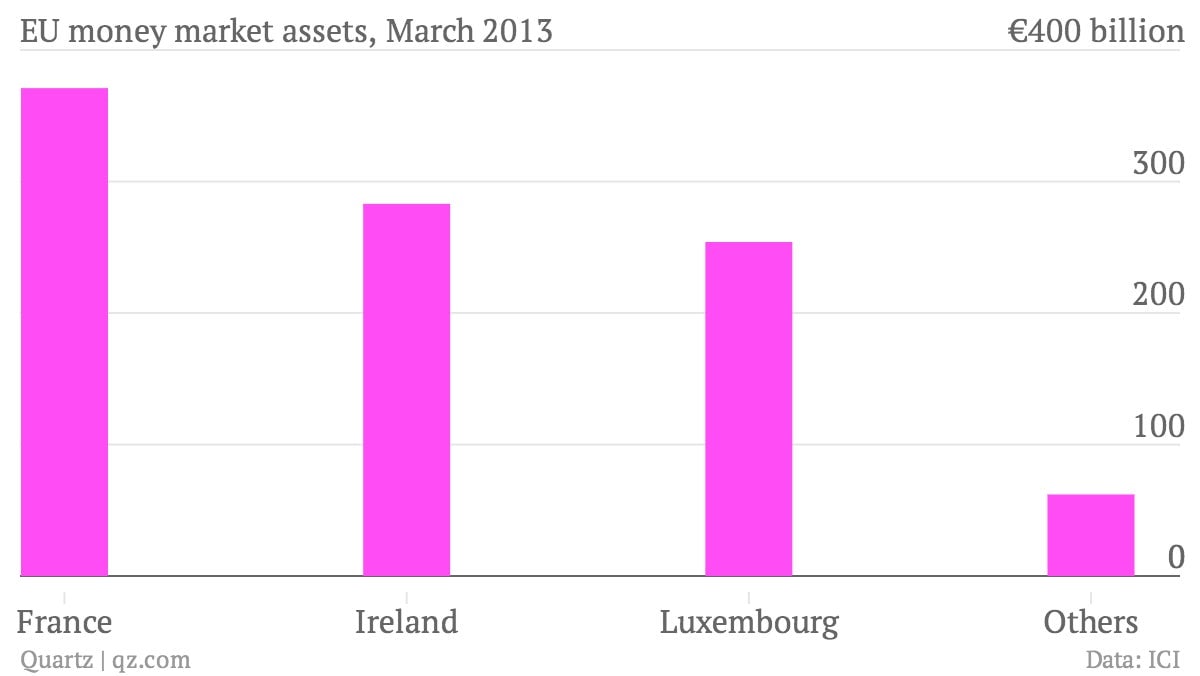Europe is moving to destroy €430 billion in money market funds beloved by banks and CFOs
“No financial market, no financial product, no financial player will escape efficient rules and oversight.” With that, European commissioner Michel Barnier (pictured above) recently unveiled a set of new rules to regulate the so-called shadow banking sector.


“No financial market, no financial product, no financial player will escape efficient rules and oversight.” With that, European commissioner Michel Barnier (pictured above) recently unveiled a set of new rules to regulate the so-called shadow banking sector.
This amorphous corner of the financial system, worth some $67 trillion, comprises a quarter of global financial assets (at least, so we think; it’s dark in the shadows). These players are not subject to regulations as strict as those imposed on banks, insurers, pension funds and other traditional financial firms. This makes policymakers understandably nervous.
Barnier’s proposal features the standard Brussels fare of vaguely-defined frameworks and road maps. Amidst the waffle, however, are some surprisingly chunky rules for money market funds (MMFs). If implemented, they could spell the end for a sizeable share of the region’s asset management industry.
MMFs in the European Union manage around €1 trillion ($1.3 trillion) and play a large role in providing short-term financing to a range of borrowers. These funds buy between one-fifth and one-third of all short-term debt issued by governments, banks and companies. For investors, they are a popular place to park cash, diversifying away from banks while receiving marginally higher interest. An important subset of these funds maintain a constant net asset value (NAV)—effectively, their price per share—and thus serve as alternatives to bank accounts. But these funds are not backed by deposit insurance like bank accounts, so investors are not protected against potential losses. Constant NAV funds control €434 billion in assets, according to the European Systemic Risk Board (pdf).
To maintain a constant NAV—typically €1, £1 or $1 per share—fund managers must invest wisely or, when times are tough, get outside help to paper over losses. The commission wants to force these funds to stand on their own; under the new rules, constant NAV funds will be required to set aside 3% of their assets as a cash buffer. If they can’t, or won’t, their NAV must float according to underlying asset values, like any other investment fund. (For the intrepid, the full text of the proposed regulation - pdf.) For their part, companies prefer constant NAV funds for accounting reasons, given that putting money in floating-price funds requires them to calculate and pay taxes on capital gains, a costly hassle for the mundane purpose they serve.
Why care about a rule targeting a subset of a subset of the shadow banking industry? First, although it is small relative to shadow banking as a whole, any market worth more than €400 billion is worth paying attention to. Second, if we’ve learned anything since the financial crisis it is that leverage has the power to transform seemingly small movements in asset values into catastrophically large losses on banks’ balance sheets. It is for this reason that, in addition to the 3% buffer, the commission’s new rules prohibit banks from supporting any MMFs that they control.
Breaking the buck
Banks borrow from MMFs, deposit money with MMFs, and own many MMFs. The New York Fed estimates that banks control around 40% of the money market industry. Remember that the minimum global standard for bank leverage—to be phased in by 2018—only requires banks to set aside equity worth 3% of total assets. If a bank-owned MMF ran into trouble and required cash from a thinly-capitalized owner to defend its €1-per-share price, the dominoes begin to fall.
The object lesson is the Reserve Primary Fund. In September 2008, when the $62 billion fund “broke the buck“ (i.e. was forced to re-price its NAV below $1), nervous investors yanked some $300 billion from MMFs in a week. The panic stopped only after the Federal Reserve stepped in to temporarily guarantee the $1 NAV of all funds, putting it on the hook for some $3 trillion in fund assets. A study of American MMFs by the Federal Reserve Bank of Boston reckons that more than 30 funds would have broken the buck between 2007 and 2011 if not for the support of outside sponsors. As it happens, a loss of 3% of the value of its holdings in Lehman Brothers debt triggered the Reserve Primary Fund’s eventual demise, as the European Commission noted prominently when proposing a cash buffer of a similar size.
Regulators in the US are also trying to tighten rules on MMFs, which former SEC chairman Mary Schapiro called a key piece of “unfinished business” from the financial crisis. The SEC’s most recent proposals, published for comment in June, include some rules to force a floating NAV, but only in limited cases. Even so, the comments on the plans are overwhelmingly opposed to forcing even a small group of funds to float their prices.
Europe’s plan to impose a cash buffer on constant NAV funds will effectively kill them off. To maintain this buffer, the commission estimates that costs for fund managers will rise by between 3% and 10% per year. For constant NAV funds, which levy fees of only around 0.08% of assets, the business model breaks down; an industry group calculates that fees would need to rise almost four fold to cover the buffer, which would send investors to cheaper competitors outside of the EU.
Irish eyes unsmiling
As with so many other aspects of post-crisis financial regulation, the price of stability is steep. In Europe’s case, the pain of new money market rules would be highly localized. Around 95% of Europe’s MMF industry is run by funds in France, Ireland and Luxembourg; constant NAV funds, however, are almost exclusively based in Ireland and Luxembourg (two-thirds in the former, one-third in the latter). Despite its high concentration of MMFs, France was among the countries calling for an outright ban of constant NAV funds before Barnier announced the commission’s plans.

There will be some respite for constant NAV fund managers, because the legislative wheels of Brussels turn slowly. The commission’s proposals are unlikely to reach the European parliament before its members are distracted by elections in May. At the earliest, then, these rules—in their current or some amended form—would not take effect until late 2014. Despite this potential delay, Barnier’s plans are an important statement of intent. Corporate treasurers at multinational companies that use constant NAV funds will certainly appreciate the implications.
Earlier this year, Moody’s published a report about the impact of mooted new regulations facing the MMF industry (titled, ominously enough, “A Business Model Hangs in the Balance.”) If all MMFs in Europe switched to floating NAVs, it predicts large outflows from constant NAV funds, perhaps as much as 50% of assets under management. If constant NAV funds instead built up 3% buffers, offering lower yields and higher fees as a result, the outflows would be merely “substantial,” at between 30% and 50% of assets. The likely beneficiaries would be US-based funds, thanks to their similar offerings and more lenient rules (which are not without their critics, from a financial-stability standpoint). More than two-thirds of investors in Irish and Luxembourgish funds come from outside the EU.
Despite the money market industry’s size, European officials appear convinced that the risks are not worth the benefits of keeping it in its current form. That those benefits are concentrated in two of its smaller states with outsized financial services industries that largely cater to foreigners makes it even easier to shine an uncomfortable light into an otherwise dark corner of the industry.